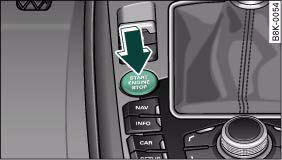Starting the engine with the Start/Stop
button
You can use the Start/Stop button to switch on the ignition and start the engine.

Fig. 132 Audi advanced key: START/STOP button
Ц Manual gearbox: Press the clutch pedal all the way down
and move the gear lever into neutral.
Ц Automatic gearbox: Press the brake pedal and move the
selector lever to position P or N ⇒  .
.
Ц Press the Start/Stop button ⇒ fig. 132 to start the engine.
If you press the Start/Stop button without pressing the clutch or brake pedal, the ignition will be switched on (and will be switched off if you press the button again). Diesel engines are preheated when the ignition is switched on.
If the engine fails to start straight-away, switch off the starter after about 10 seconds and try again after about half a minute.
When starting from cold the engine may be a little noisy for the first few seconds until oil pressure has built up in the hydraulic tappets.
This is quite normal and no cause for concern.
Driving away from a standstill
On some vehicles, the engine revs are automatically increased slightly as soon as you release the clutch. This helps you drive off more smoothly.
Driver message in the instrument cluster display
No key identified
This message appears when you press the Start/Stop button if there is no remote control key inside the vehicle or if the system cannot detect or identify the key. This can happen, for example, if the radio signal from the key is obstructed by a metal briefcase or similar.
Electronic equipment, such as mobile phones, can also interfere with the radio signal from the key.
Press brake pedal to start engine
This message appears on automatic vehicles if you press the Start/Stop button to start the engine without first pressing the brake pedal. The engine will only start if you press the brake pedal.
Press clutch pedal to start engine
This message appears on manual vehicles if you press the Start/Stop button to start the engine without first pressing the clutch pedal. The engine will only start if you press the clutch pedal.
Engage N or P to start engine
This message will appear if you try to start the engine when the selector lever of the automatic gearbox is not in P or N. The engine can only be started if the selector lever is in one of these positions.
Key not in vehicle
This message will appear together with the symbol if the remote control key is removed from the vehicle while the engine is running.
This is to remind you not to continue driving without the key (for example if you change drivers).
If the remote control key is not in the vehicle you will not be able to switch on the ignition or restart the engine after it has been switched off. Without the key, you will also not be able to lock the vehicle from the outside.
Shift to P, otherwise vehicle can roll away. Doors do not lock if lever is not in P. or Please move selector lever to position P. Vehicle cannot be locked.
For safety reasons, this message will appear and a warning buzzer will sound if the selector lever of the automatic gearbox is not in position P when you switch off the ignition with the Start/Stop button. Put the selector lever in position P; otherwise the vehicle can roll away. If the lever is not in position P you will not be able to lock the vehicle using the exterior locking switch on the door handle or the remote control key.
Advanced key defective! Use ignition lock
This message appears if the vehicle has to be started with the ignition key instead of the Start/Stop button.
Steering lock
The steering is locked if the key is not in the ignition and the driver door has been opened. The steering lock acts as a theft deterrent.
 WARNING
WARNING
Never run the engine in confined spaces. The exhaust gases are
toxic.
Х Never switch off the engine until the vehicle is stationary.
Х The brake servo and the power steering system work only
when the engine is running. You need more strength to steer and
brake the vehicle when the engine is switched off. This would
mean a greater risk of accidents and serious injury, because you
cannot steer and brake in the normal manner.
 Caution
Caution
Х Avoid high engine speeds, full throttle and extreme load conditions
until the engine has reached its normal operating temperature,
otherwise this can damage the engine.
Х The engine cannot be started by push-starting or towing.
Х If the engine has been working hard for a long time, there is a risk
of heat building up in the engine compartment after the engine has
been switched off; this could cause engine damage. For this reason,
you should leave the engine idling for about 2 minutes before
switching it off.
